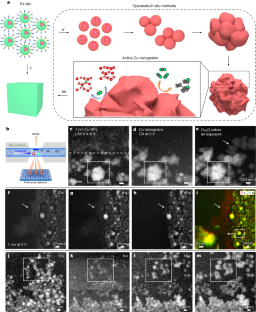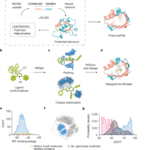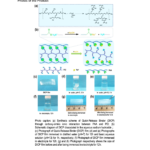2023-02-16 アメリカ合衆国・ローレンスバークレー国立研究所(LBNL)

・ LBNL、カリフォルニア大学バークレー校(UCB)およびコーネル大学が、CO2 と水を再生可能燃料や化学物質(エチレン、エタノール、プロパノール)に変換する銅ナノ粒子による働きの新たな見識を、そのリルタイム撮像を通して獲得。人工光合成を通じた CO2 の再生可能なソーラー燃料への変換実現への一歩となる。
・ operando 4D 電気化学的液体セル走査透過電子顕微鏡(STEM)と呼ばれる新しい撮像技術と軟 X線プローブを組合せ、液体中の銅ナノ粒子のサンプルを調査。4D STEM は様々な材料の原子・分子領域をマップアウトし、軟(低エネルギー)X 線は実際の環境下で化学反応をリアルタイムで追跡する。
・ 電気化学的液体セルは STEM と X 線の両機器に適合し、人間の毛髪よりも細い設計によりデリケートなサンプルを電子ビームによるダメージから保護しながら安定して撮像する。
・ 4D STEM による調査では、液体セルにより CO2 電解中の 7nm~18nm の銅ナノ粒子が数秒でより大きな金属銅のナノグレインに展開することを確認。同セルでは、10nm を下回るサイズのオブジェクトの解像が可能。
・ 同じ液体セルを使用した軟 X 線共鳴散乱(RSoXS)により、銅ナノグレインによる CO2 還元の促進状況を調査し、数千個のナノ粒子間での多量の反応をリアルタイムで観察して化学反応物質と生成物を正確に同定。金属銅ナノグレインが CO2 還元の活性部位として機能することがわかった。
・ CO2 電解では、「電気分解的スクランブリング」と呼ばれるプロセスで、銅ナノ粒子がその構造を変化させる。銅ナノ粒子の酸化表面層が劣化して開口部ができ、そこに CO2 分子が付着し、それにより電子が CO2 へと移動してエチレンを始め様々な多炭素製品を生産する化学反応が起こる。
・ また、7nm 銅ナノ粒子のみが CO2 還元に関与したことで、粒子サイズの重要性も確認。金属銅のみが多炭素製品を効率的に生産することもわかった。さらに、7nm ナノ粒子では CO2 還元開始に要するエネルギーがバルクの銅触媒よりも約 300mV 低いことも確認。CO2 から多炭素製品を作る最高性能触媒の作動に必要な電力量は 1V。
・ 米国エネルギー省(DOE)が資金を提供する Liquid Sunlight Alliance(LiSA)にて、 次世代ソーラー燃料デバイス設計に銅ナノグレイン触媒の使用を計画している。本研究は、DOE の科学局が支援した。
URL: https://newscenter.lbl.gov/2023/02/16/copper-catalyst-converts-co2-into-liquid-fuels/
<NEDO海外技術情報より>
関連情報
Nature 掲載論文(アブストラクトのみ:全文は有料)
Operando studies reveal active Cu nanograins for CO2 electroreduction
URL: https://www.nature.com/articles/s41586-022-05540-0
Abstract
Carbon dioxide electroreduction facilitates the sustainable synthesis of fuels and chemicals1. Although Cu enables CO2-to-multicarbon product (C2+) conversion, the nature of the active sites under operating conditions remains elusive2. Importantly, identifying active sites of high-performance Cu nanocatalysts necessitates nanoscale, time-resolved operando techniques3,4,5. Here, we present a comprehensive investigation of the structural dynamics during the life cycle of Cu nanocatalysts. A 7 nm Cu nanoparticle ensemble evolves into metallic Cu nanograins during electrolysis before complete oxidation to single-crystal Cu2O nanocubes following post-electrolysis air exposure. Operando analytical and four-dimensional electrochemical liquid-cell scanning transmission electron microscopy shows the presence of metallic Cu nanograins under CO2 reduction conditions. Correlated high-energy-resolution time-resolved X-ray spectroscopy suggests that metallic Cu, rich in nanograin boundaries, supports undercoordinated active sites for C–C coupling. Quantitative structure–activity correlation shows that a higher fraction of metallic Cu nanograins leads to higher C2+ selectivity. A 7 nm Cu nanoparticle ensemble, with a unity fraction of active Cu nanograins, exhibits sixfold higher C2+ selectivity than the 18 nm counterpart with one-third of active Cu nanograins. The correlation of multimodal operando techniques serves as a powerful platform to advance our fundamental understanding of the complex structural evolution of nanocatalysts under electrochemical conditions.




